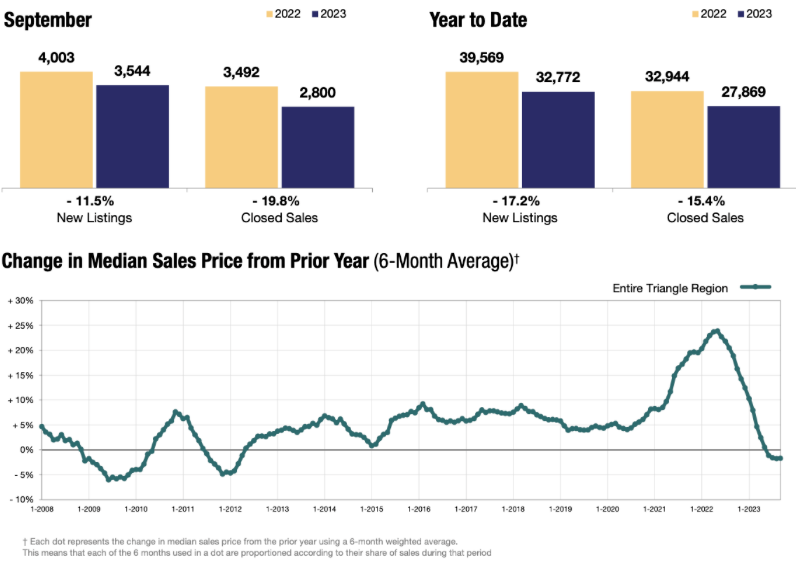The Triangle real estate market, with its rich history and vibrant communities, has always attracted homeowners and investors alike. For anyone who has been following the local housing trends, it’s no secret that home prices have seen fluctuations over the past year. However, diving deep into the data can help us understand these shifts better and perhaps provide some peace of mind to both prospective buyers and sellers.
A Closer Look at the Triangle Region
Drawing insights from the recent “Local Market Update – September 2023” provided by Triangle MLS, there are evident changes in new listings, closed sales, and median sales prices. In September 2023 alone, new listings decreased by 11.5%, and closed sales went down by 19.8% when compared to 2022. On the brighter side, the median sales price saw only a slight decrease of 0.7%.
When we extend our view to the year-to-date data, the new listings for 2023 have decreased by 17.2%, and closed sales have also reduced by 15.4%. Despite these decreases, the median sales prices have shown resilience, increasing by 1.3% compared to 2022.

Interpreting the Numbers
The earlier part of 2022 saw a significant surge in home prices. These increases were not sustainable and hence led to a correction in the latter part of the year. Contrary to media’s portrayal, which often focused on the dips, 2023 paints a picture of stabilization in the Triangle real estate market.
It’s important to note that despite the corrections in 2022, the data shows a trend towards more typical price appreciation in 2023. This is excellent news for the Triangle housing market, indicating a move towards balance.
Factors Impacting Triangle’s Home Prices
Now, let’s address the burning question: Why are home prices in the Triangle region increasing now?
One primary reason is the classic economic principle of supply and demand. The Triangle region, like much of the nation, hasn’t seen a sufficient number of homes available for sale to meet the demand. While higher mortgage rates might have tempered buyer enthusiasm, they also limited the supply of available homes. Many existing homeowners have resisted selling, not wanting to part with their low mortgage rates.
This phenomenon, referred to as the ‘mortgage rate lock-in effect,’ means that the supply of homes is squeezed even further. With more buyers than homes available for sale, prices naturally trend upwards.

What This Means for You
For Buyers: Hesitating to buy because of potential price drops? The upward trend should ease your concerns. Investing in the Triangle real estate market means owning a piece of property that’s likely to appreciate over time.
For Sellers: Been on the fence about selling due to changing home prices? Now might be the time to jump in. The recent data suggests that home prices are turning favorable, making it a prime time to list.
In Conclusion
For those who’ve been apprehensive about the Triangle real estate market due to the uncertainties of fluctuating home prices, it’s essential to understand the broader picture. The Triangle, with its thriving communities and rich heritage, remains a strong contender for homeownership and investment. Let’s connect to discuss how these trends are specifically playing out in our local neighborhoods and what they mean for you.
